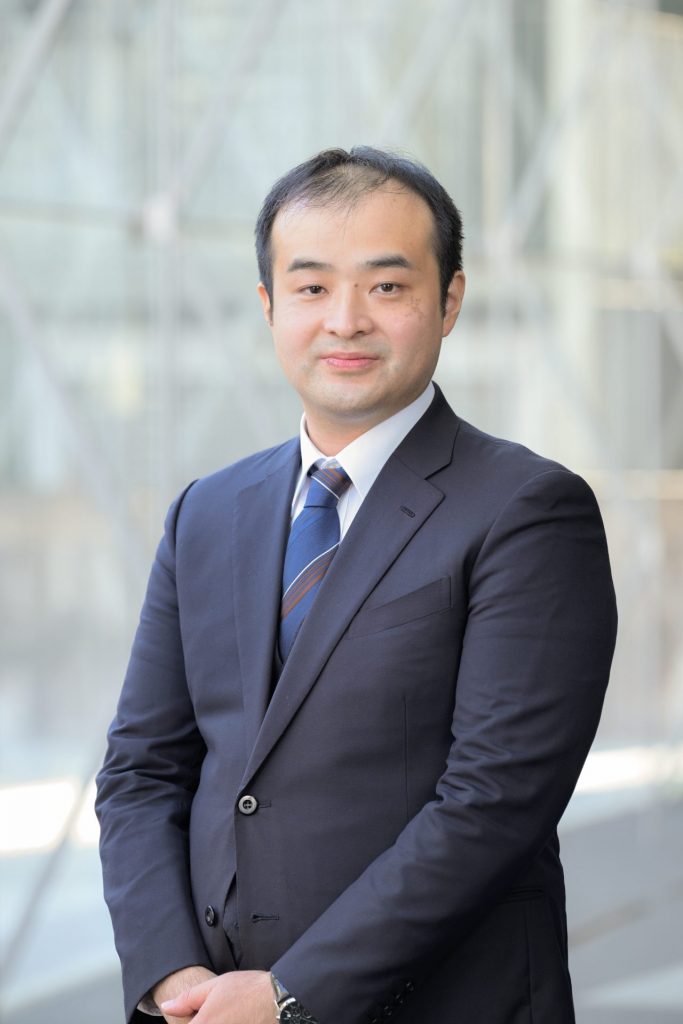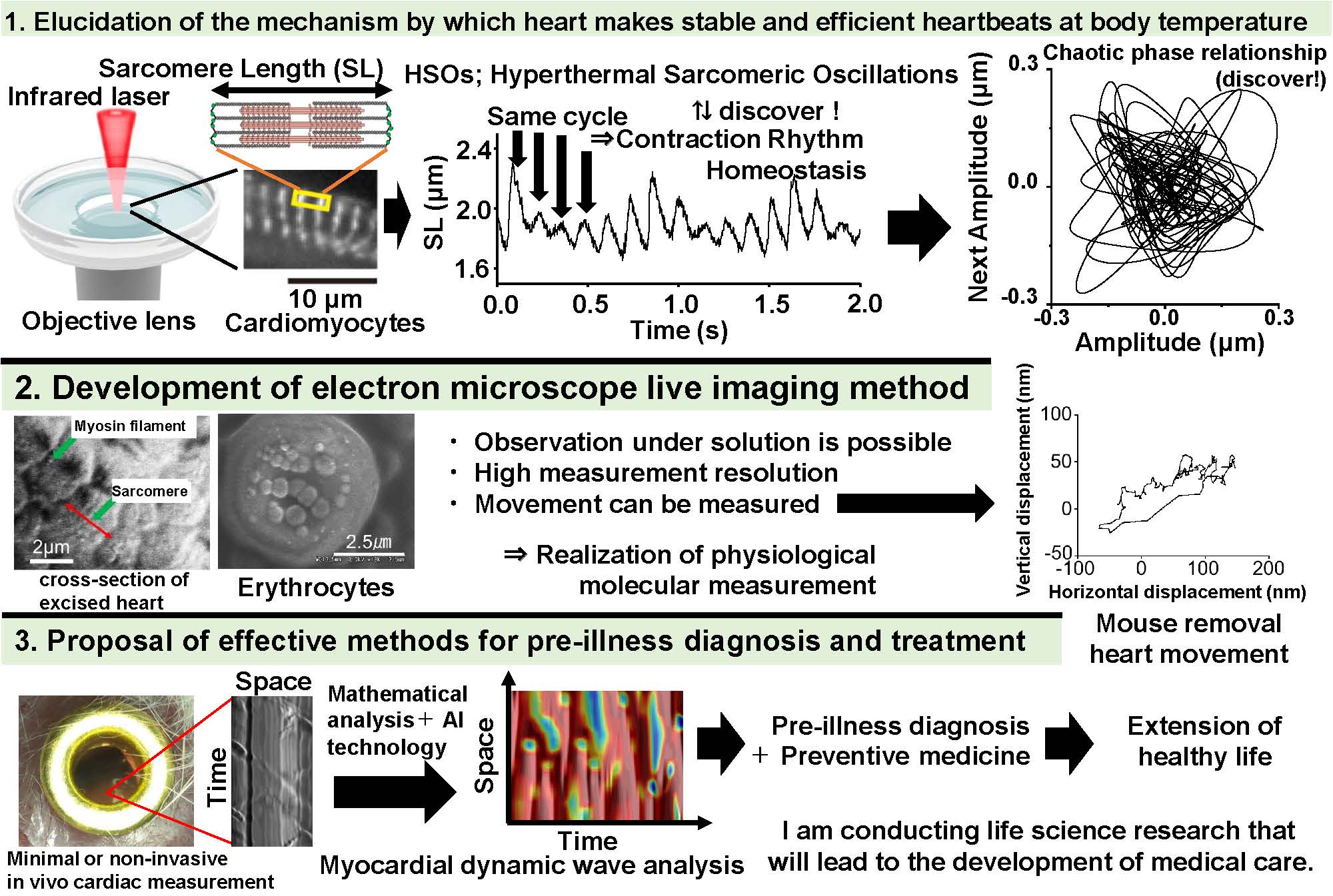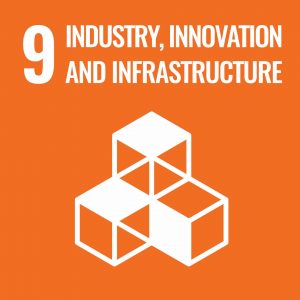Biophysics
Physiology
Medical engineering
Information science
Microscopy

SHINTANI A. Seine
Starting year 2022
Chubu University
Department of Biomedical Sciences, College of Life and Health Sciences / Center for Mathematical Science and Artificial Intelligence / Center for Clinical Examination Practicum Support
Associate Professor
Research Areas:Life Science
Nanotechnology/Materials
Manufacturing Technology (Mechanical Engineering, Electrical and Electronic Engineering, Chemical Engineering)
Natural Science
Others
Research fields
Research Interests
Heart Physiology
Contraction Rhythm Homeostasis
Sarcomere Chaos
Real-time Electron Microscopy
Pre-illness Diagnosis
Professional Memberships
Biophysical Society (U.S.A.)
The Biophysical Society of Japan
The Physiological Society of Japan
The Japanese Society of Microscopy
Japanese Society for Chronobiology
Japan Society for Cell Biology
Society of Nano Science and Technology
Main research topics
Summary: I am researching how nanoscale biomolecules produce robust heartbeat rhythms. I found that myocardium uses the heat of body temperature to create a contractile rhythm that combines chaotic instability and homeostatic stability (figure). And I got a mathematical model prediction that its contractile rhythm characteristics are important for rapid ventricular dilation with each dilation of the heart. It is strongly suggested that this result may lead to pre-illness diagnosis and preemptive medical care for heart disease, and I am currently conducting research with this exit orientation.
Hyperthermal sarcomeric oscillations (HSOs): I have discovered that by warming myocardial cells to about body temperature, sarcomeres inside cardiomyocytes become HSOs, which repeatedly contract and relax in a cycle close to the heartbeat. Interestingly, HSOs kept their cycle constant despite their sensitive changes in amplitude and waveform under the influence of changes in intracellular calcium concentration. Furthermore, HSOs have found that the amplitude and phase are chaotically changed in order to achieve both responsiveness and stability.
Electron microscope live imaging method (DET film method): We have developed a technology for observing the structure and “movement” of submerged samples such as wet organs as they are with a scanning electron microscope. This measurement is possible by creating and using a thin film (DET film: Deformable and Electron Transmissive Film) that can withstand the pressure difference between vacuum and atmospheric pressure and has excellent electron beam permeability and deformability. Currently, I am conducting research and development toward the realization of observation and measurement of various nanoscale dynamics.





Representative papers
Seine A. Shintani.⁎, Seiji Yamaguchi and Hiroaki Takadama, Real-Time Scanning Electron Microscopy of Unfixed Tissue in Solution using a Deformable and Electron-Transmissive Film., Microscopy, dfac030, 2022.
Seine A. Shintani.⁎, Hyperthermal sarcomeric oscillations generated in warmed cardiomyocytes control amplitudes with chaotic properties while keeping cycles constant., Biochemical and Biophysical Research Communications, 611, 8-13, 2022.
Research URL
researchmap https://researchmap.jp/Seine_A_Shintani
Laboratory HP https://sites.google.com/view/shintani-lab/top
Interview article of Chubu University https://www.chubu.ac.jp/chubuly-style/757/
NEDO Research Seeds Introduction https://wakasapo.nedo.go.jp/seeds/seeds-1839/
Press release of recent research results 1 https://www.chubu.ac.jp/news/5561/
Press release of recent research results 2 https://www.chubu.ac.jp/news/3240/
Interview
No interview
News
-
お知らせ
T‑GEx Associate Dr. Seine A. Shintani (Chubu University) Launches the NIBB‑CU Hackathon 2025 — Registration Now Open
-
お知らせ
The research result of T-GEx associate Dr. SHINTANI A.Seine, Chubu University, was published in Biochemical and Biophysical Research Communications and a press release was made.
-
お知らせ
<Message from the Organizer> Research Outcomes Exhibition 2024 –Education and Research in the AI Era-
-
お知らせ
T-GEx Associate Dr. SHINTANI A. Seine, Chubu University, won the Excellence Award for Digital Promotion Human Resource Development Program sponsored by METI.
-
お知らせ
T-GEx Associate Dr. SHINTANI A. Seine, Chubu University, won 2nd prize at the NIBB AI-Biology Ideathon 2024.
-
お知らせ
The research result of T-GEx Associate Dr. SHINTANI A. Seine, Chubu University, was published in “Biochemical and Biophysical Research Communications”.
-
お知らせ
T-GEx Associate Dr. SHINTANI A. Seine, Chubu University, received the Aichi Prefecture Wakashachi Encouragement Award for Most Excellence.
-
お知らせ
The research result of T-GEx Associate Dr. SHINTANI A. Seine, Chubu University, was published in ” Biophysics and Physicobiology “.
-
お知らせ
T-GEx Associate Dr. SHINTANI A. Seine, Chubu University, won the Evident Award at the corporate participation pitch contest co-sponsored by the Biophysical Society of Japan Annual Meeting.
-
お知らせ
T-GEx Associate Dr. SHINTANI A. Seine, Chubu University, won the Evident Award at the corporate participation pitch contest co-sponsored by the Biophysical Society of Japan Annual Meeting.
-
お知らせ
T-GEx Associate Dr. SHINTANI A. Seine, gave a lecture introducing the use of chatGPT data analysis for Chubu University faculty and students.
-
お知らせ
T-GEx Associate Dr. SHINTANI A. Seine, Chubu University, has been certificated as INNO-β, the Strategic Information and Communications R&D Promotion Programme(SCOPE) of the Ministry of Internal Affairs and Communications.
-
お知らせ
T-GEx Associate Dr. SHINTANI A. Seine, Chubu University, received the Best Poster Award at the 29th Annual Meeting of the Japanese Society for Chronobiology.
-
お知らせ
T-GEx Associate Dr. SHINTANI A. Seine, Chubu University, received a prize at the Company Participation Pitch Contest co-organised by the Annual Meeting of The Biophysical Society of Japan.
-
お知らせ
The paper of T-GEx Associate Dr. SHINTANI A. Seine, Chubu University, has been ranked No. 1 in the most read ranking in the international journal of Microscopic Science “Microscopy”.
-
お知らせ
An interview article by T-GEx Associate Dr. SHINTANI A. Seine,Chubu University, was published in The Mainichi Shimbun.
-
お知らせ
A paper by T-GEx Associate Dr. SHINTANI A. Seine, Chubu University, was published in Microscopy.

